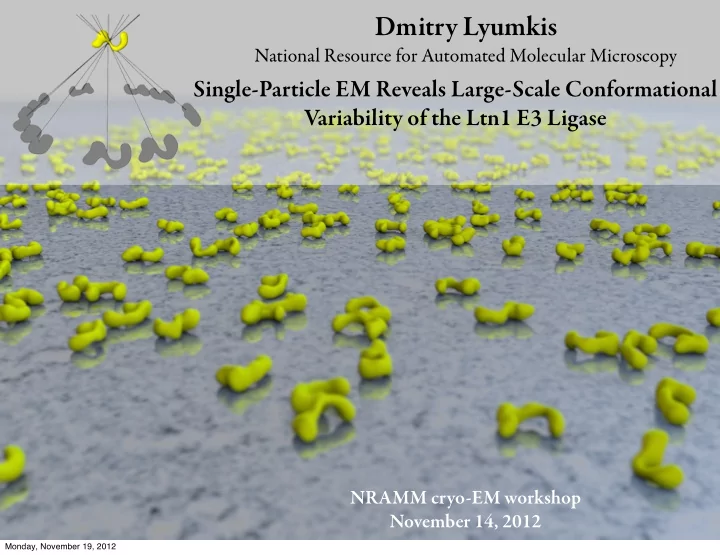

Dmitry Lyumkis National Resource for Automated Molecular Microscopy Single-Particle EM Reveals Large-Scale Conformational Variability of the Ltn1 E3 Ligase NRAMM cryo-EM workshop November 14, 2012 Monday, November 19, 2012
E3 ubiquitin ligases 1. proteasome-mediated protein degradation 2. progression of the cell cycle 3. apoptosis 4. DNA transcription and repair target protein poly-ubiquitin 5. ... and virtually every process in the cell Ub Ub Ub Ub Ub O O NH 2 NH NH Ub O SH SH S E2 E2 E2 substrate substrate substrate E3 E3 E3 Komander, D. and M. Rape (2012). "The ubiquitin code." Annu Rev Biochem 81 : 203-229 Monday, November 19, 2012
Ltn1 is a RING-E3 ubiquitin ligase that is responsible for protein quality control in eukaryotes negative stain micrograph of Ltn1 200 Å Bengtson, M. H. & Joazeiro, C. A. Nature 467 , 470-473 (2010) Monday, November 19, 2012
data collection and particle extraction untilted micrograph region (0°, 2um def, 2% UF) tilted micrograph region (55°, 2um def, 2% UF) 200 Å 200 Å Monday, November 19, 2012
alignment, classification, & 3D reconstruction 1 reference-free / reference- based alignment & classification iterative 2 RCT reconstruction from tilted particles corresponding to each untilted class 3 combine reconstructions from similar volumes (different is >10° change in terminus rotation) final volume: final volume: 4 if RCT volume is adequate, conformation 1 conformation 2 remove reconstructed particles from data & repeat 1-3 Monday, November 19, 2012
automated RCT infrastructure in Appion database record class correspondence iterative translational refinement using established Euler database records angles 1. tilted particle • original particle in stack counterpart 2. tilted micrograph • alignment parameters 3. tilt angle (rot, shx, shy, mirror) • class correspondence RCT volume Monday, November 19, 2012
automated RCT results Monday, November 19, 2012
Ltn1 shows extensive conformational variability about two hinge regions row merges hinge 1: terminus-1 flexing column merges 200 Å hinge 2: terminus-2 rotation Monday, November 19, 2012
Ltn1 contains 2 conserved termini RING E3s are responsible for two functions: (1) substrate recognition (2) recruitment of E2-Ub conjugate sequence conservation between orthologs domain analysis Monday, November 19, 2012
... so we made a truncated protein to orient the termini micrograph portion of ∆ N-Ltn1 (amino acids 477-1562) Monday, November 19, 2012
Orientation of Ltn1 ʼ s N and C termini RING E3s are responsible for two functions: (1) substrate recognition, (2) recruitment of E2-Ub conjugate C1 C2 C3 C4 ∆ N-Ltn1 Class Average (amino acids 477-1562) Ltn1 Class Average (amino acids 1-1562) ∆ N-Ltn1 3D reconstruction (amino acids 477-1562) Ltn1 3D reconstruction (amino acids 477-1562) overlay 200 Å Monday, November 19, 2012
Ltn1 in vitreous ice Does the same mobility occur in a more native environment? Monday, November 19, 2012
Mobility of Ltn1 ʼ s termini is present in frozen hydrated preparations (cryo-EM) primary variance within data (intra-model heterogeneity) (1) recalculate 10,000 volumes by bootstrap resampling 1 model (2) calculate variance Penczek, P. A., M. Kimmel, et al. (2011). Structure 19 (11): 1582-1590 variance between 4 models reconstructed volumes (inter-model heterogeneity) Scheres, S. H. (2012)." J Struct Biol (1) Ltn1 exhibits similar heterogeneity in ice as it does in stain, and its basic architecture is preserved (2) predominant heterogeneity within the structure accounts for the mobility of its C- terminus Monday, November 19, 2012
Ltn1 is similar to CRL E3s in overall shape and size Zheng, N., et al. (2002). Nature 416 (6882): 703-709 RCT reconstruction 1 RCT reconstruction 2 overlay MD fit to 1 MD fit to 2 MD simulations Liu, J. and R. Nussinov (2011). JBC 286 (47): 40934-40942 (1) The employed strategy using negative stain is identifying real mobility within the protein (2) Ltn1 ʼ s mobility cannot be simply explained by its large size and extended shape Monday, November 19, 2012
relevance of flexibility within the ribosomal context of protein quality control Monday, November 19, 2012
Model of Ltn1 E3 function within the context of protein quality control protein structures drawn to scale (1) mediate poly-ubiquitylation (2) recognize different target lysines in a heterogeneous and dynamic environment specific to protein quality control Monday, November 19, 2012
validation / optimization of RCT results 1. look at the particles within your class homogeneous class heterogeneous class 2. minor things - careful tilt-pair matching (especially when it is done automatically), FSC value, curve, etc. 3. effects of specimen flattening: different structure by RCT may not always mean different conformation and/or composition Cheng, Y., E. Wolf, et al. (2006). "Single particle reconstructions of the transferrin- transferrin receptor complex obtained with different specimen preparation techniques." J Mol Biol 355 (5): 1048-1065 Monday, November 19, 2012
conclusions 1. Ltn1 is a highly dynamic protein and this may have functional implications for its role in protein quality control 2. Growing evidence that flexibility plays an important role in E3 ubiquitin ligases 3. RCT as a robust methodology for sorting heterogeneity in single-particle data • fair amount of automation (record keeping!) • data collection in stain ~= RCT 4. public availability of the negative stain dataset: http://maskiton.scripps.edu Monday, November 19, 2012
anks to ... Collaborators Principal Investigators Claudio Joazeiro Mario Bengtson AMI / Joazeiro groups Bridget Carragher Joong-Won Lee Clinton Potter Chris Lima see below Ron Milligan Selom Doamekpor Claudio Joazeiro Matt Petroski Tasha B. Toro Monday, November 19, 2012
Recommend
More recommend